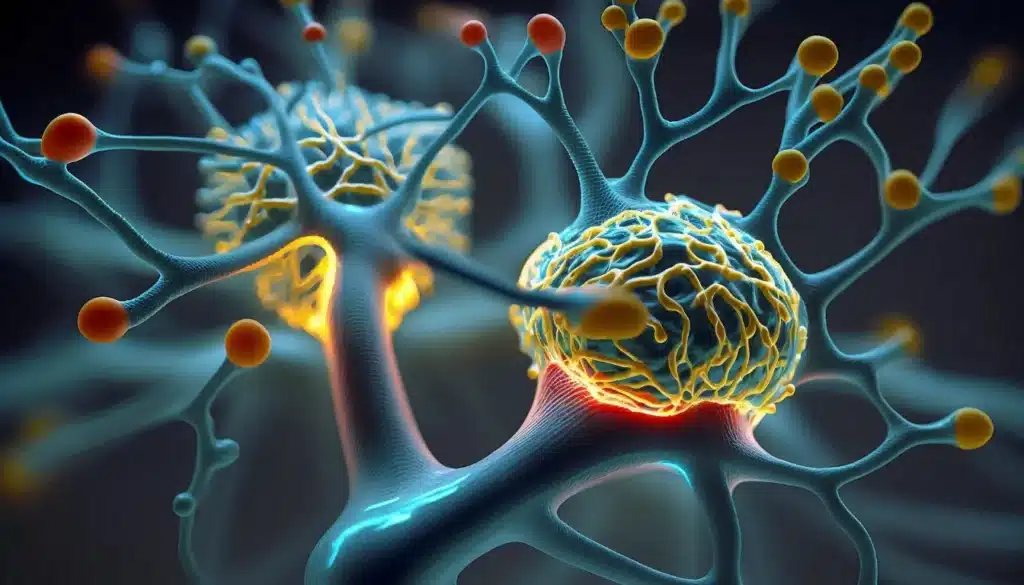
Written by Dr. Diane Mueller
If you’re dealing with Lyme disease, it can sometimes feel like your brain was wrapped in fog so thick you couldn’t find your way out. But that mental haze might not be “just stress” – it could be your nervous system sending out an SOS. When tiny spirochetes from infected ticks make their way past your blood-brain barrier, they don’t just crash the party… they redecorate the whole house.
Lyme disease neurological symptoms affect up to 15% of untreated patients, turning sharp minds into scattered puzzle pieces. It causes neurological symptoms like memory lapses or sudden facial paralysis, often mimicking conditions like depression or dementia. It’s a complex infection requiring careful understanding to uncover what’s truly going on.
Neurological symptoms affect up to 15% of untreated Lyme disease patients. They can include brain fog, memory loss, facial palsy, and peripheral neuropathy caused by Borrelia burgdorferi bacteria crossing the blood-brain barrier and triggering widespread inflammation.
Standard Lyme testing misses 50-65% of early neurological cases, making cerebrospinal fluid analysis essential for accurate diagnosis when blood tests are negative but neurological symptoms persist.
Lyme disease commonly mimics severe neurodegenerative conditions like ALS, Parkinson’s disease, and Alzheimer’s, leading to frequent misdiagnosis and delayed treatment that can result in permanent neurological damage.
Co-infections and environmental toxins significantly complicate recovery, with tick-borne diseases like babesiosis and anaplasmosis, plus mold exposure, amplifying neurological symptoms and requiring comprehensive testing beyond standard Lyme panels.
Functional medicine approaches address root causes by supporting detoxification pathways, reducing neuroinflammation through anti-inflammatory diets and supplements, and healing the gut-brain connection alongside antimicrobial treatment.
Prevention and early intervention are critical since neurological symptoms can become permanent if left untreated, making daily tick checks, proper repellents, and immediate medical attention for suspicious symptoms essential for long-term brain health.
You’ve likely heard the phrase “it’s all in your head“ more times than you can count. The truth is, when Lyme disease targets your nervous system, it’s literally in your head, and it’s devastatingly real.
The neurological cascade begins almost immediately after infection. Borrelia burgdorferi, the bacteria causing Lyme disease, targets the brain and nervous system, acting like an intrusive guest that disrupts everything.
Within weeks of Lyme disease infection, the blood-brain barrier becomes compromised, allowing inflammation to disrupt neural pathways. This leads to brain fog, memory issues, and confusion, often described as feeling like the mind is dimmed and unclear.
The symptoms don’t follow a neat checklist—they’re more like a chaotic storm system moving through your nervous system:
Memory issues hit hard and fast. You might remember every lyric from a song you heard in 1987, but can’t recall what you had for breakfast. Your short-term memory becomes Swiss cheese, full of holes you didn’t ask for.
Cognitive processing slows to a crawl. Simple math that once took seconds now requires serious mental gymnastics. Reading comprehension plummets, and following conversations feels like trying to catch butterflies with a broken net.
Concentration becomes your nemesis. You start tasks with good intentions, then find yourself three hours later wondering how you ended up reorganizing your sock drawer instead of answering emails.
Traditional medicine treats symptoms like isolated events rather than pieces of a complex puzzle. Functional medicine takes a step back and asks the bigger question: Why is this happening?
Your gut-brain connection plays a starring role in Lyme neurological symptoms. That bacterial imbalance in your gut triggers inflammation signals to your brain through the vagus nerve, the body’s main communication pathway.
Detoxification pathways become overwhelmed faster than a single parent during the holiday shopping season. Your liver, kidneys, and lymphatic system simply can’t keep up with the toxic load from dying bacteria and inflammatory byproducts.
Standard Lyme disease treatment often stops at antibiotics, which, don’t get me wrong, have their place. But addressing Lyme neurological symptoms requires a more sophisticated strategy.
Supporting your mitochondria becomes essential. When Lyme bacteria camp out in your brain tissue, they steal energy from your cellular batteries—no wonder you feel like you’re running on empty.
Reducing neuroinflammation isn’t just about popping anti-inflammatory supplements (though targeted ones help). It’s about addressing the root causes: gut dysfunction, toxic overload, and immune system confusion.
Your brain needs specific nutrients to heal—omega-3 fatty acids, B-vitamins, and antioxidants aren’t just nice-to-haves; they’re essential repair materials for damaged neural tissue.
Phase one focuses on reducing the bacterial load while supporting your body’s natural refresh pathways. Think of it as clearing out the unwelcome houseguests while repairing the damage they’ve caused.
Phase two rebuilds and repairs. Your brain has remarkable neuroplasticity—its ability to form new neural connections and heal damaged pathways. With the proper support, those cognitive abilities can return stronger than before.
Phase three maintains your progress and prevents relapse. This isn’t a sprint; it’s a marathon with rest stops and victory celebrations along the way.
The journey back to neurological health isn’t linear. Some days you’ll feel like your old sharp self, others like you’re swimming through mental molasses. That’s not failure—that’s healing happening in real time.
Remember: your brain fog, memory lapses, and cognitive struggles aren’t character flaws or signs of weakness. They’re your nervous system crying out for help, and with the right functional medicine approach, that help is absolutely within reach.

Your brain isn’t betraying you—there’s something more serious happening when Lyme disease affects your nervous system.
Borrelia burgdorferi directly attacks the nervous system, causing inflammation that can significantly impair brain function. Symptoms include brain fog, tingling, numbness, facial palsy, nerve irritation, meningitis, and disrupted basic functions like heart rate and digestion. In severe cases, it can mimic conditions like ALS, Parkinson’s, or Alzheimer’s. The bacteria can also trigger autoimmune responses, causing the immune system to attack nervous tissue.
Lyme disease is often misdiagnosed because it mimics other neurodegenerative diseases. Many patients don’t develop the signature bull’s-eye rash, and standard tests miss nearly half of early cases since antibodies may not have formed yet. This leads to mislabels like stress-related cognitive issues or dementia, while the actual cause—a treatable bacterial infection—remains undetected. Neurological symptoms are diverse, causing doctors to treat them separately instead of identifying the underlying Lyme disease.
Your brain doesn’t lie to you when something’s seriously wrong. These neurological symptoms aren’t random quirks or signs you’re “getting older”—they’re your nervous system waving red flags.
Brain fog from Lyme disease feels like mental molasses—forgetting words, struggling to focus, and feeling disconnected. It’s caused by inflammation from Borrelia bacteria affecting the brain and gut-brain connection, not just stress or fatigue. Processed foods and sugar worsen symptoms, while anti-inflammatory foods like salmon, leafy greens, and berries help nourish and support brain health.
About 9% of Lyme disease patients experience facial palsy**, where one side of the face weakens or droops, often appearing before Lyme disease is diagnosed. This happens due to inflammation of the facial nerve. Early treatment with antibiotics like doxycycline can reverse the condition, but delays may cause permanent damage. Facial palsy is a warning sign of serious nervous system issues.
Lyme disease can cause nerve issues like random sharp pains, numbness, and tingling in your limbs, making you feel disconnected from your body. This happens because Borrelia bacteria inflame peripheral nerves, disrupting standard signals. Nutrients like choline and alpha-lipoic acid are essential for healing and protecting nerve damage, helping to restore proper function.
When Lyme bacteria infect the central nervous system, they can cause meningitis, leading to severe symptoms like fever, intense neck stiffness, crushing headaches, and sensitivity to light. Early blood tests might appear normal, so spinal fluid analysis is crucial to confirm the infection. If you have these symptoms and a history of Lyme exposure, seek thorough testing immediately.
Your autonomic nervous system may malfunction due to Lyme disease, causing heart palpitations, dizziness, and unstable blood pressure. A functional medicine approach suggests staying hydrated, balancing electrolytes, managing stress, and using simple methods like increasing salt intake, gentle yoga, and proper hydration to stabilize symptoms while treating the infection.
Lyme is certainly not the only cause of these sorts of diseases and other causes should also be considered. But, because there is a link in research, it is worth getting properly tested (not all tests are the same) for Lyme Disease if you have any of these conditions.
The neurological chaos that Lyme disease creates gets tangled up with other conditions so frequently that it’s become medicine’s version of a shell game.
Lyme disease can imitate neurological conditions like Parkinson’s and ALS so effectively that even skilled doctors may misdiagnose it.
Some ALS patients treated for suspected Lyme disease with antibiotics saw their symptoms disappear, suggesting a possible connection between the two conditions.
The distinction between actual ALS and Lyme-induced pseudo-ALS remains unclear, prompting the need to rule out Lyme disease during neurodegenerative diagnoses.
Lyme disease can also mimic Parkinson’s symptoms, such as tremors and a shuffling gait, but its impact on the brain differs from Parkinson’s.
Many neurologists don’t routinely test for Lyme disease, leading to missed opportunities for accurate diagnoses and timely treatments.
Ticks often transmit multiple infections, not just Lyme disease, such as anaplasmosis and babesiosis.
These co-infections worsen neurological symptoms, making diagnosis and treatment more challenging.
Babesiosis can lead to brain fog and memory problems, while anaplasmosis can cause confusion and altered mental states.
Functional medicine focuses on detecting and treating all related infections, not just Lyme, for comprehensive care.

Mold toxins can worsen Lyme disease neurological symptoms, especially for those genetically sensitive to mold. These toxins cross into the brain, killing nerve cells and potentially triggering conditions like dementia and autoimmune disorders. Combined with Lyme-related neuroinflammation, mold exposure creates severe cognitive issues. Mold effects vary by genetics, mold type, and health. Some people feel fine in moldy environments, while others develop significant neurological symptoms. Many Lyme patients see improvements after removing mold from their homes. Testing for mold in your home and checking for mycotoxins in your body can reveal hidden problems. Mold issues can even exist in dry areas like Colorado. If your Lyme symptoms resist treatment, mold and other environmental toxins might be the hidden cause, requiring attention beyond the infection itself.
Functional medicine takes a “fix the foundation first“ approach rather than just masking symptoms. Think of it like renovating a house—you wouldn’t paint over water damage without fixing the leak, right?
When Borrelia bacteria die, they release toxins that overwhelm the liver. Supporting the liver beforehand helps manage this better. Supplements like myrrh, choline, and TUDCA assist in detoxifying the body.
Near-infrared light therapy can aid in cellular repair and boost energy by improving mitochondrial function. Short sessions (15-20 minutes) may help alleviate extreme fatigue.
Inflammation from Lyme disease disrupts your brain’s neural networks, causing chaos.
To reduce this, avoid refined carbs and sugar, and focus on an anti-inflammatory diet with foods like wild-caught fish, olive oil, colorful vegetables, and berries. Omega-3s, curcumin, and resveratrol are key for calming brain inflammation and reducing neural disruption, acting like a firefighting team for your brain.
Doctors often overlook the connection between the gut and the brain, especially in Lyme disease. Gut dysbiosis, or an imbalance of harmful bacteria in the intestines, can worsen neurological symptoms.
Probiotics, like Lactobacillus rhamnosus and Bifidobacterium longum, help restore gut health and support the brain. Fermented foods like sauerkraut, kimchi, and kefir are also beneficial. Prebiotics, found in foods like garlic, onions, and asparagus, nourish good bacteria and further improve gut health.
Standard treatment begins with antibiotics. Doxycycline or IV ceftriaxone are antibiotics commonly used for Lyme, especially in severe neurological cases.
Herbal treatments can assist. Natural remedies like oregano oil, cat’s claw, and Japanese knotweed complement antibiotics, reducing resistance and side effects.
Preparation is key. Starting with liver support and herbal antimicrobials before antibiotics may help minimize harsh bacterial die-off effects.
B vitamins (B12, folate) and magnesium help repair and calm the nervous system.
Acetyl-L-carnitine aids in repairing nerve damage, reducing tingling and numbness after consistent use.
Managing stress through techniques like meditation or deep breathing helps stabilize the nervous system.
Functional medicine focuses on restoring the body’s resilience alongside treating Lyme disease symptoms.
Standard Lyme testing misses neurological cases more often than a blindfolded archer.
The CDC’s two-step testing for Lyme disease—EIA followed by Western blot—only detects 35–50% of early cases*. Early-stage neurological symptoms often go undiagnosed because your body hasn’t produced enough antibodies yet. To make matters worse, other infections can cause false positives, creating confusion.
CSF analysis is crucial when standard blood tests fail, as it detects Borrelia-specific antibodies in the central nervous system, proving the bacteria have crossed the blood-brain barrier.
Doctors need CSF and serum samples to confirm higher antibody levels in spinal fluid, indicating the nervous system is fighting the infection.
Functional medicine testing can go beyond traditional panels, using urinary mycotoxin tests to check for mold exposure and genetic tests to spot detoxification vulnerabilities.
While advanced tests are costly, they save time and money by addressing root causes instead of just chasing symptoms.
Negative blood tests do not rule out neurological Lyme disease—patients may need antimicrobial treatment, not psychiatric evaluations.
If Borrelia bacteria invade the nervous system, cerebrospinal fluid (CSF) testing is essential.
Doctors must consider clinical history, like exposure to tick-heavy areas or symptom cycles, not just lab results.
Lyme tests measure immune response, not the bacteria themselves, so compromised immunity may lead to false negatives.
Proper diagnosis requires a comprehensive approach—symptoms are real and warrant a thorough investigation.

Your best defense against Lyme neurological symptoms starts before you ever encounter a tick. Innovative prevention paired with long-term management strategies can make the difference between recovery and prolonged suffering.
Wear light-colored clothing to spot ticks easily.
Use EPA-registered repellents with DEET or picaridin for reliable protection; avoid relying on natural alternatives in high-risk areas.
Perform daily tick checks, focusing on areas like behind the ears, hairline, and warm, hidden spots.
Strengthen your immune system with vitamin C, zinc, and echinacea to help your body respond if exposed.
Post-Treatment Lyme Disease Syndrome affects 5-10% of patients who continue experiencing fatigue, pain, or cognitive issues even after completing antibiotic treatment. Your lingering symptoms aren’t “all in your head“—they’re real and they deserve attention.
Address persistent inflammation first through targeted anti-inflammatory protocols. Curcumin, resveratrol, and omega-3 fatty acids can help calm the inflammatory cascade that keeps your nervous system irritated.
Support your detoxification pathways with gentle liver support herbs like milk thistle and dandelion root. Your body’s been through a war—it needs help clearing the cellular debris.
Explore co-infections and environmental triggers that might be complicating your recovery. Babesia, Bartonella, or mold exposure can all mimic or worsen Lyme neurological symptoms. Comprehensive testing often reveals the missing puzzle pieces.
Gentle exercises, such as light resistance training and stretching, improve neurological function; aim for 10-15 minutes of consistent daily movement.
Avoid inflammatory foods like refined sugars, processed oils, and gluten; focus on anti-inflammatory whole foods to reduce neuroinflammation.
Prioritize quality sleep by maintaining good sleep hygiene—keep your room cool, dark, and tech-free to allow your brain to detoxify.
Practice stress management through mindfulness activities like meditation or yoga to reduce stress hormones and support your immune system.
Your neurological symptoms aren’t imaginary, and they’re not permanent. Lyme disease creates real changes in your brain and nervous system that require targeted treatment approaches.
The path forward starts with proper testing that goes beyond standard blood work. If you’re experiencing brain fog, memory issues, or unexplained neurological symptoms, don’t accept dismissive explanations about stress or aging.
Consult a Lyme disease expert who understands functional medicine approaches to Lyme neurological symptoms. Your recovery depends on addressing root causes rather than just managing symptoms.
Remember, healing takes time, and setbacks don’t mean failure. With comprehensive testing, proper treatment protocols, and lifestyle modifications, you can reclaim your cognitive clarity and neurological health.
The primary neurological symptoms include brain fog, memory problems, cognitive impairment, facial paralysis (Bell’s palsy), tingling and numbness in limbs, severe headaches, and concentration difficulties. These symptoms affect up to 15% of untreated patients and occur when Borrelia bacteria cross the blood-brain barrier, causing inflammation in the nervous system.
Standard CDC two-step testing only catches 35-50% of early Lyme cases and often fails to detect neurological involvement. Cerebrospinal fluid (CSF) analysis is more accurate for neurological Lyme diagnosis as it can reveal Borrelia-specific antibodies in the central nervous system that blood tests might miss.
Borrelia bacteria compromise the blood-brain barrier shortly after infection, causing inflammation and direct damage to nervous system cells. This leads to chaotic disruptions in memory, cognitive processing, and concentration. The bacteria trigger inflammatory responses that interfere with normal brain function and neural communication.
Yes, Lyme disease can mimic serious conditions like ALS, Parkinson’s disease, and Alzheimer’s. This leads to frequent misdiagnosis because symptoms overlap significantly. Some patients initially diagnosed with ALS have experienced symptom resolution after proper Lyme treatment, highlighting the importance of comprehensive testing for tick-borne diseases.
Functional medicine focuses on five key areas: supporting detoxification to manage toxins from dying bacteria, reducing neuroinflammation through diet and supplements, addressing gut-brain axis imbalances, implementing antimicrobial protocols, and supporting nervous system repair with essential nutrients and stress management techniques.
Yes, ticks often carry multiple pathogens including anaplasmosis and babesiosis, which can complicate neurological symptoms. These co-infections require comprehensive testing and treatment as they can amplify cognitive issues and create more complex symptom patterns that are harder to diagnose and treat.
Mold toxins can significantly amplify Lyme-related cognitive issues, creating a complex symptom picture. Mold exposure weakens the immune system and increases inflammation, making it harder for the body to fight the Lyme infection. Home mold testing and remediation may be necessary for complete recovery.
Yes, recovery is achievable with proper treatment. The recovery process involves three phases: reducing bacterial load, rebuilding neural pathways, and maintaining progress. However, the journey isn’t linear and requires a comprehensive approach addressing the infection, inflammation, and supporting overall nervous system health.
Many patients don’t recall tick bites because ticks can be very small (size of a poppy seed) and their bites are often painless. Additionally, only 30-80% of Lyme patients develop the characteristic bull’s-eye rash, and it may appear in areas that are difficult to see, leading to missed early diagnosis opportunities.
Steere, A. C. (2001). Lyme disease. New England Journal of Medicine, 345(2), 115–125. https://doi.org/10.1056/NEJM200107123450207
*Steere, A. C., Berardi, V. P., Weeks, K. E., Logigian, E. L., & Ackermann, R. (1990). Evaluation of the intrathecal antibody response in the diagnosis of Lyme neuroborreliosis. Journal of Infectious Diseases, 161(6), 1203–1209. https://doi.org/10.1093/infdis/161.6.1203
**Halperin, J. J. (2018). Neurologic manifestations of Lyme disease. Infectious Disease Clinics of North America, 32(3), 627–641. https://doi.org/10.1016/j.idc.2018.04.004
Aucott, J. N. (2013). Posttreatment Lyme disease syndrome. Infectious Disease Clinics of North America, 27(4), 769–781. https://doi.org/10.1016/j.idc.2013.08.001
Borrelia is the bacteria that causes Lyme Disease. Borrelia has the ability to attack the neurons (nervous system cells) and damage them. It can cause autoimmune processes to activate causing our own immune system to also play a role on attacking our nervous system.[1]
There are a few cases in research that have been studied regarding the misdiagnosis of ALS. In these studies, ALS sufferers were given antibiotics to treat Lyme Disease and their symptoms went away.[2] It is a thin line between whether we can say this was truly ALS or it was misdiagnosed and it was actually Lyme. We say “thin line” here because it is not totally clear in the literature yet if Lyme Disease causes ALS or simply a pseudo-ALS that has quite similar symptoms in some people. Regardless, there is enough potential overlap here that looking for Lyme Disease in this population is really important.
Parkinson’s Disease is another example of possible sequelae of Lyme Disease neurological symptoms. In some studies, Lyme Disease has been shown to manifest very similar symptoms as parkinson’s disease. Just like ALS, if someone has a Parkinson’s Disease diagnosis, it is super important to consider Lyme Disease as the culprit cause. When geographic regions of the brain were compared in research there was no similarity between Lyme Disease and Parkinson’s
[1] Wirsching I, Ort N, Üçeyler N. ALS or ALS mimic by neuroborreliosis-A case report. Clin Case Rep. 2019 Dec 11;8(1):86-91. doi: 10.1002/ccr3.2569. PMID: 31998493; PMCID: PMC6982520.
[2] Hänsel Y, Ackerl M, Stanek G. ALS-ähnlicher Krankheitsverlauf bei chronischer Neuroborreliose [ALS-like sequelae in chronic neuroborreliosis]. Wien Med Wochenschr. 1995;145(7-8):186-8. German. PMID: 7610670.
We have helped thousands of
people restore their health
and quality of life by diagnosing
and treating their Lyme Disease.
“Dr. Mueller’s approach to medicine is refreshing! There is only so much you can do with western medicine and in my life I was needing a new approach. By addressing the whole body, nutritional diet factors, environmental factors, blood work, and incorporating ideas I had not previously known, I was able to break through with my conditions. I am not only experiencing less pain in my life, but through the process of healing guided by Dr. Diane Mueller, I am now happy to say I have more consciousness surrounding how I eat, what to eat and when things are appropriate. Living by example Dr. Mueller has a vibrancy that makes you want to learn and know more about your body and overall health. I highly recommend her to anyone looking for new answers, a new approach to health, or in need of freedom from pain and limitations.”
-Storie S.
Kihei, HI
